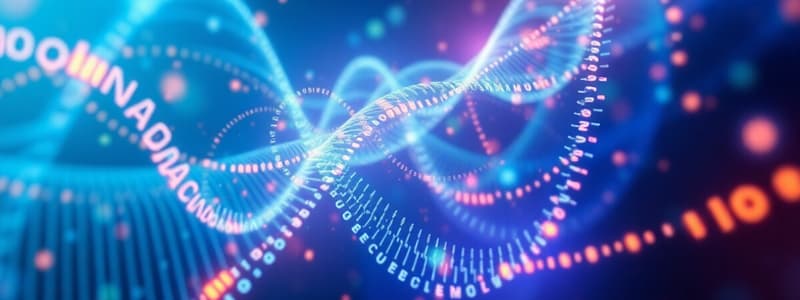Podcast
Questions and Answers
What is the primary building block of deoxyribonucleic acid (DNA)?
What is the primary building block of deoxyribonucleic acid (DNA)?
- Amino acids
- Nucleotides (correct)
- Proteins
- Sugars
What type of sequence alignment is primarily concerned with evolutionary relationships?
What type of sequence alignment is primarily concerned with evolutionary relationships?
- Pairwise Sequence Alignment (correct)
- Genetic Variance Alignment
- Functional Sequence Alignment
- Multiple Sequence Alignment
What distinguishes orthologous genes from paralogous genes?
What distinguishes orthologous genes from paralogous genes?
- Orthologous genes are derived from a common ancestor, while paralogous genes arise from gene duplication. (correct)
- Orthologous genes share the same function, while paralogous genes do not.
- Orthologous genes result from environmental adaptations, while paralogous genes do not.
- Orthologous genes are found within the same species, while paralogous genes are found in different species.
Which methodology is NOT typically implemented in sequence analysis?
Which methodology is NOT typically implemented in sequence analysis?
What is the primary structure of a protein composed of?
What is the primary structure of a protein composed of?
What is the primary purpose of pairwise sequence alignment?
What is the primary purpose of pairwise sequence alignment?
How did myoglobin and hemoglobin originate?
How did myoglobin and hemoglobin originate?
Which statement about global alignment is true?
Which statement about global alignment is true?
When is local alignment primarily used?
When is local alignment primarily used?
What is a key characteristic of paralogous genes?
What is a key characteristic of paralogous genes?
Orthologous genes share the same function across different species.
Orthologous genes share the same function across different species.
Paralogous genes are homologous genes that arise from different ancestral genes.
Paralogous genes are homologous genes that arise from different ancestral genes.
The nucleic acid sequence of RNA is made up of adenine, thymine, guanine, and cytosine.
The nucleic acid sequence of RNA is made up of adenine, thymine, guanine, and cytosine.
Sequence alignment is primarily used for genetic disorder identification.
Sequence alignment is primarily used for genetic disorder identification.
Homologs are genes that have completely diverged functions and do not share evolutionary ancestry.
Homologs are genes that have completely diverged functions and do not share evolutionary ancestry.
Flashcards are hidden until you start studying
Study Notes
Sequence Analysis
- A biological sequence is a single, continuous molecule of nucleic acid or protein.
- Nucleic acids are composed of nucleotides, with DNA containing adenine, thymine, guanine, and cytosine, and RNA containing adenine, uracil, guanine, and cytosine.
- Protein primary structure is composed of a linear chain of amino acid molecules.
- Key methodologies in sequence analysis include:
- Sequence alignment
- Phylogenetic analysis
- Identification of novel genes for drug development
Pairwise Sequence Alignment
- Sequence alignment is a fundamental method used to identify regions of similarity between two or more sequences.
- These conserved regions often indicate functional, structural, or evolutionary relationships.
- Homologs are genes that share evolutionary ancestry, regardless of their current function.
- Orthologs are homologous genes found in different species that evolved from a common ancestral gene. They generally retain the same function across species.
- Paralogs are homologous genes that arise within the same species due to gene duplication. After duplication, they can evolve new functions or specialized roles.
Global and Local Alignment
- Global alignment aligns the entire length of two sequences from start to end.
- Local alignment finds the best matching region within parts of the sequences, particularly useful for sequences differing in length.
- The Needleman-Wunsch algorithm, the first dynamic programming application for biological sequence analysis, is used for global alignment.
- The Smith-Waterman algorithm is used for local alignment, finding local matches within sequences instead of the entire sequence.
NCBI-BLAST
- BLAST (Basic Local Alignment Search Tool) is a widely used tool for sequence alignment and similarity searches.
- It can be used for analysis of thousands of sequences and even for comparing two genomes.
- BLAST offers seven subprograms for various alignment scenarios:
- BLASTn: aligns nucleotide query sequence with nucleotide database.
- BLASTp: aligns protein sequence with protein database.
- BLASTx: aligns nucleotide sequence with protein database using six-frame translation.
- tBLASTx: aligns six-frame translated nucleotide query sequence with translated nucleotide sequences of the database.
- tBLASTn: aligns protein query sequence with translated nucleotide database.
Sequence Analysis
- A biological sequence is a continuous molecule of nucleic acid or protein.
- Nucleic acid sequences are composed of nucleotides (adenine, thymine, guanine, and cytosine for DNA, and adenine, uracil, guanine, and cytosine for RNA).
- The primary protein structure is a linear chain of amino acids.
- Sequence analysis methods include:
- Sequence alignment
- Phylogenetic analysis
- Identification of novel genes for drug development.
Pairwise Sequence Alignment
- Homologs are genes derived from a common ancestral gene that share evolutionary ancestry.
- Orthologs are homologous genes found in different species that evolved from a common ancestor through speciation.
- Paralogs are homologous genes that arise within the same species due to gene duplication.
- Pairwise alignment aims to find conserved regions between two or more sequences to highlight functional, structural or evolutionary relationships.
- Global alignment aligns the entire length of two sequences from start to end. Global alignment is used for sequences of similar length.
- Local alignment identifies the best matching region within portions of sequences. Local alignment is used for sequences with significant length differences.
Methods for Sequence Alignment
- Smith-Waterman algorithm, a dynamic programming algorithm, is used for local alignment.
- Needleman-Wunsch algorithm, another dynamic programming algorithm, is used for global alignment.
NCBI-BLAST
- BLAST (Basic Local Alignment Search Tool) is widely used for sequence alignment and similarity searches. It can analyze thousands of sequences and even compare two genomes.
- BLAST is freely accessible and downloadable from NCBI.
- BLAST subprograms:
- BLASTn: aligns nucleotide query sequence with nucleotide database.
- BLASTp: aligns protein sequence with protein database.
- BLASTx: aligns nucleotide sequence with protein database by translating the nucleotide sequence into all six possible reading frames.
- tBLASTx: aligns a query nucleotide sequence (translated into all six reading frames) with the translated nucleotide sequences of the database.
- tBLASTn: aligns a protein query sequence with translated nucleotide sequences within the database.
Studying That Suits You
Use AI to generate personalized quizzes and flashcards to suit your learning preferences.




